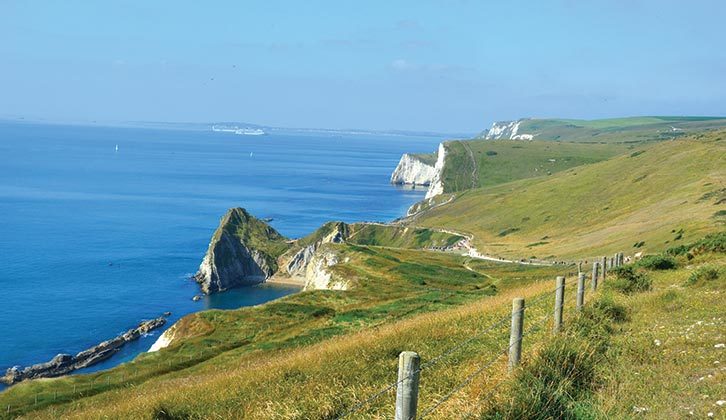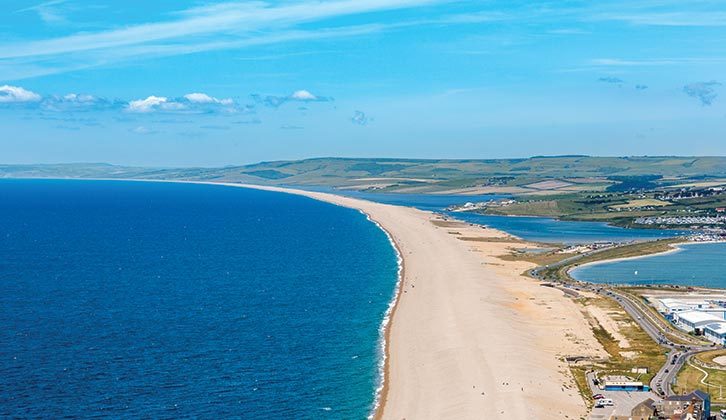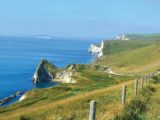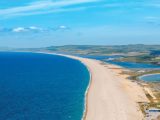In March 2011, we stayed at Hunter’s Moon Caravan and Motorhome Club Site, near Wareham, in Dorset, and enjoyed the most wonderful weather. Two years later, again in March, we woke to a dusting of snow and bitterly cold winds. This time, we would be exploring Dorset in early autumn, and were hoping for an Indian summer.
The first day dawned sunny, so we drove to Studland Bay, which is managed by the National Trust and offers visitors gorgeous beaches and heathland bordering Poole Harbour, just perfect for excellent birdwatching.
We parked at the National Trust car park, which has room for motorhomes, and then walked along to beautiful Shell Beach, which is sheltered by dunes.
Magnificent views along the Jurassic Coast
Returning towards Studland, we took the path to Knoll Beach. Here, you can hire boats, canoes and paddle boards and stop off at the café, where we enjoyed tea and scones. There’s a really magnificent view of Old Harry Rocks from here, but we were planning to get a bit closer.
We parked at South Beach, near the village, and picked up the coastal path, passing Grade II listed Fort Henry, a World War Two observation bunker. Studland and its beaches were used for training before the D-Day landings.
The chalk cliffs are popularly known as Old Harry Rocks, but strictly speaking, it’s only the outer stack that is so named. This is the end of the famous Jurassic Coast, which starts at Exmouth, and on a gloriously sunny day, the white cliffs and stacks were stunning against the brilliantly blue sea.
Historic firing ranges
The weekend was approaching and I had spotted that the Lulworth Ranges, military firing ranges located between Wareham and Lulworth, would be accessible to the public.
We wanted to visit the long abandoned village of Tyneham, now on the firing range, which was evacuated in 1943 to support the war effort.

The villagers expected to return after the war, but that didn’t happen, so the place remains deserted. The ruins of Post Office Row greet the eye, comprising a cottage, the post office and
the head teacher’s house. (The road to the village is fairly narrow, so shouldn’t be attempted if you don’t have a small motorhome.)
From the village, it’s a 20-minute walk to the coast and the beautiful, secluded Worbarrow Bay. Retracing our steps, we visited Tyneham Farm, which has been partially restored.
Then, we drove to Swanage (try the North Beach or Main Beach car parks), where we found ourselves in the midst of the Swanage Folk Festival. We had the best BLTs ever at the Sea Breeze restaurant, with a front row seat to watch some of the lively dance troupes on the promenade.
Next day, we drove to the Isle of Portland, which is not an island at all, but is linked to the mainland by a causeway starting at Chesil Beach. The road climbs up to provide a great view of the famous pebble beach stretching into the distance. Portland Bill is the tip of the isle, marked by the iconic red and white lighthouse.

We sat, admiring the view, and devoured our scones with raspberry jam and clotted cream. After a pleasant stroll and a fascinating chat with a man who used to inspect lighthouses for a living, we moved on to Weymouth, where there’s a handy park and ride service (postcode DT3 5HJ).
This is a typical buckets-and-spades resort, in a crescent-shaped bay with a long promenade. There’s an enthusiastic sailing community here and Weymouth hosted this element of the 2012 Olympic Games. Walking on the prom, we saw an impressively large sand sculpture. We learned that Weymouth sand is perfect for sculpting!
Cycling in the nature reserve
Next morning, which promised another sunny day, we drove back to Studland Bay, offloaded our bikes and took the ferry that crosses Poole Harbour to Sandbanks.
Cycling through Sandbanks, we picked up the promenade route and went on via Bournemouth to Hengistbury Head, and a trail through the nature reserve. We lunched by Christchurch Harbour, then continued to another pretty beach.
The following day, as a change from coastal visits, we drove inland to Sherborne (motorhomes are allowed to use the commercial spaces at the Culverhayes car park, postcode DT9 3ED), where you can explore the abbey, almshouses and two castles. There was a Saxon cathedral here, then a Benedictine abbey, and these days, the parish church. Sherborne is compact and walkable.
We strolled up Cheap Street, packed with shops and eateries, and paused at Reeve the Baker for chicken baps, before walking to the ruined 12th-century castle just outside town.
This is known as the Old Castle and from there, we spotted the 16th-century castle, aka the New Castle, built by Sir Walter Raleigh in 1594.
Next day, we were back at the coast again, to enjoy the spectacular views. We drove through the Lulworth Estate to the car park above the iconic and much photographed limestone arch of Durdle Door. We walked down to the edge of the cliffs for the best viewpoint. Afterwards, we puffed back up the hill, bought some bottles of water and continued up to Lulworth Cove.

Sailing to Brownsea
We were nearing the end of our holiday, but had two more visits planned. We’d booked tickets for the Poole to Brownsea Island ferry, so parked up at Poole Quay and walked over to the passenger ferry terminal (the previous service from Sandbacks is currently suspended, until further notice).
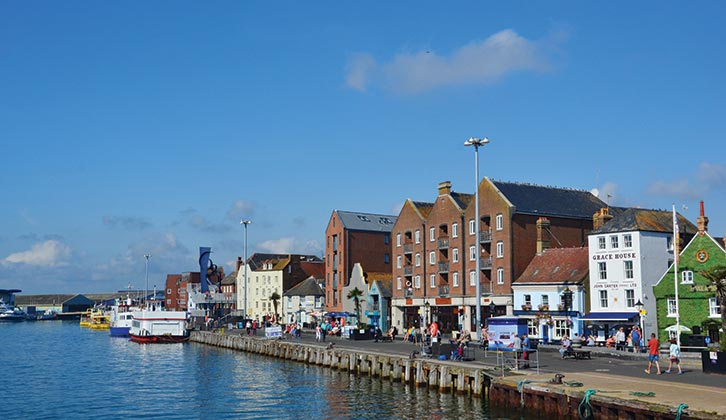
It’s a 20-minute trip across the water to Brownsea’s jetty, where we alighted and set off to explore. We took along a picnic lunch, which we enjoyed while looking back across the water to picturesque Poole.
In 1907, Lord Baden-Powell set up a camp on the island, which led to the formation of the Scout movement. These days, Brownsea is a nature reserve, managed by Dorset Wildlife Trust.

There’s a colony of red squirrels here and, on our return walk, we were fortunate enough to come across five youngsters, who were busy scurrying up and down a tree. What a delight it was to be able to see these lovely (and now rather rare) creatures.
Not wanting to waste a minute of our holiday, we’d also booked tickets for a visit to the nearby Bovington Tank Museum. On entering the first room, there’s a large collection of tanks to be explored, starting with the first one ever built, nicknamed ‘Little Willie’. Next to this is its successor, known as ‘Mother’, which could apparently cross obstacles more easily.

Tanks from all over the world are displayed in the collection, including US Shermans and German Panzers, as well as the most recent British model, the upgraded Challenger 2.
We were lucky enough to enjoy sunshine and blue skies every day on our trip, and our Indian summer showcased the beautiful coast and countryside of Dorset to its very best effect.
Are you thinking of embarking on a tour to the region? Then our guide to the best motorhome parks in Dorset will help you choose the right campsite to stay at.
Tour essentials
Where we stayed
Hunter’s Moon Caravan and Motorhome Club Site
Cold Harbour, Wareham, Dorset BH20 7PA, www.caravanclub.co.uk
- Open: All year
- Pitches: 122
- Charges £19.45-£36.80
When to go
Hunter’s Moon Caravan and Motorhome Club Site is open all year and there are plenty of walking paths and cycling trails to enjoy in the surrounding area, but this part of the world does get busy during the summer months. For a quieter break, spring and autumn are good times to visit.
If you’re still looking for a holiday destination to head to, our campervan campsites guide will help you pick out the right site to stay at.
Way to go
From Lancashire, we took the M6, M6 toll, then M42, exiting onto the M40. We left at J9 for the A34, then joined the M3 and M27 (west). We took the A31, then the A35 via Christchurch and Poole, and the A351 towards Wareham. Follow the direction for Bere Regis on the roundabout just before Wareham.
Find out more
If you’ve enjoyed reading this article, why not get the latest news, reviews and features delivered direct to your door or inbox every month. Take advantage of our brilliant Practical Motorhome magazine SUBSCRIBERS’ OFFER and SIGN UP TO OUR NEWSLETTER for regular weekly updates on all things motorhome related.
